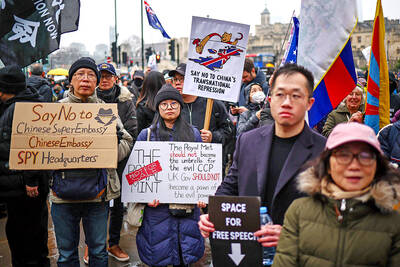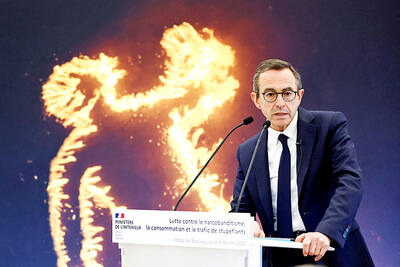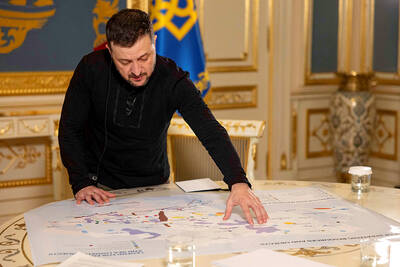An ambulance screams toward a triage hub for wounded Ukrainian soldiers outside Bakhmut, the stage for the longest battle of Russia’s invasion, where there is no end in sight to a brutal stalemate.
Men with limbs lost to mines and artillery wounds are pulled from battlefields carved with trenches and scarred by shells in a fight drawing comparisons to infamous battles of World War I.
“It’s like Verdun out there,” said Ivan, an ambulance driver waiting on a roadside outside the battered industrial city in the eastern Donetsk region.

Photo: AP
Like the 1916 fight on the western front in France, the battle for Bakhmut, now in its seventh month, has been long, bloody and futile.
Victory over the city, pounded to ruin, would be merely symbolic as the anniversary of the invasion looms on Friday next week.
Yet even as the dead and wounded are rushed out or abandoned on the battlefield, both sides are digging in and flinging more troops at Bakhmut to break the deadlock.
Moscow has ramped up efforts to score its first significant victory after months of setbacks, while Kyiv is determined to hold its ground.
“It’s a classic World War I problem,” said Mark Cancian, a senior security program adviser at the Center for Strategic and International Studies.
When Moscow’s first attempt to encircle Ukrainian forces failed, Russia “kept attacking,” he said.
Even if the Russians do succeed, “it will mean nothing operationally and strategically,” he added.
“It has a lot of symbolism, so if they captured Bakhmut, they’d make it sound like it was important, but it wouldn’t be,” Cancian said.
However, he added that Ukraine’s options are limited.
“If that’s where the Russians are attacking, the Ukrainians don’t have a choice but to defend,” he said.
British intelligence has estimated Russia’s progress to be halting, but that has not eased the pressure on Ukrainian President Volodymyr Zelenskiy, who has called for more weapons from Western nations.
“If weapon [deliveries] are accelerated — namely long-range weapons — we will not only not withdraw from Bakhmut, we will begin to deoccupy Donbas,” he told senior EU leaders in Kyiv earlier this month, referring to the wider region, including Donetsk.
“We will fight as long as we can” for Bakhmut, he said.
To keep Russia at bay, Ukraine’s forces also need more standard artillery and ammunition, Ukrainian military analyst Oleksandr Kovalenko said.
“If this does not happen, then we will have serious problems in Bakhmut,” Kovalenko said.
The lack of firepower on the front is keenly felt.
“The enemy has a huge advantage in artillery,” Yuriy Kryzhberskyi, a 37-year-old Ukrainian officer, said near the front late last month. “You can sit in a basement in the village of Vasyukivka [north of Bakhmut] for half an hour and hear 40 incoming shells.”
Russia’s strength in numbers is also daunting, said a sergeant near Soledar with the call sign “Alkor.”
“We shoot, and shoot and shoot, but after five minutes, the next 20 people are coming toward us,” he said.
Moscow and the notorious Wagner mercenary group have been accused of using ill-prepared and poorly equipped recruits as “cannon fodder” — a claim Russian military analyst Alexander Khramtchikhine dismissed as “Western propaganda.”
Ukraine’s ranks have also faced losses.
Major Volodymyr Leonov of Ukraine’s Territorial Defense Forces said in three days last month he had dozens wounded.
The bodies of five of his fighters could not be retrieved from the battlefield.
“Our people are motivated. Everyone came to fight,” he said. But “when there is no fire support and when there are no armored vehicles, we are simply shot, like in a shooting range.”
Neither Ukraine nor Moscow has given death tolls, but both sides have described the battle for Bakhmut as the bloodiest of the war.
Near the front, north of Bakhmut — among broken trees and strewn grenades — a dozen bodies of alleged Wagner fighters lay abandoned on the frosted ground, a reporter witnessed late last month.
“Apparently, they were forbidden to retreat,” Ukrainian serviceman Vladislav said, as heavy shelling pounded nearby. “They didn’t even take their wounded and they died there eventually in the field.”
Wagner boss and ally of Russian President Vladimir Putin, Yevgeny Prigozhin, has described “fierce” fighting unfolding on “every street, every house, every stairwell.”
Evidence of the fighting is everywhere, from burning buildings to shell fragments and blood-soaked snow littered with medical equipment.
A city once known for sparkling wine and salt mines, and home to 70,000 people, half of the buildings in Bakhmut are damaged or destroyed, officials said.
Rows of Soviet-era housing blocks are charred and battered, their windows exploded out across the streets.
The bridge spanning the city’s river has been reduced to a jumble of boards, tires and pallets.
Natalia Shevchenko, who makes the crossing daily for clean water — the city having lost all supply, along with gas, electricity and telephone signals — is used to the whistle of falling shells.
“I am living in the basement right now. When I get out, I am like a mole — my eyes have to get used to the light,” she said.
She is one of about 6,500 people holding out in Bakhmut, even as life is squeezed from the city.
More civilians have left since fighting intensified last month, said Tetyana Scherbak, a volunteer at a humanitarian hub.
Some wait overnight at the hub for evacuation, huddled next to stoves with salvaged belongings. Others are retrieved from their homes by people who brave shelling to reach them — sometimes getting caught in the line of fire.
“It’s all about luck there,” said 24-year-old Ukrainian volunteer Mykola, at the memorial in Kyiv for one of two British volunteers killed in the town of Soledar last month.
Earlier this month, another humanitarian, American Pete Reed, died in Bakhmut.
Nataliia Yevtushenko, 38, has tried to leave Bakhmut twice.
The first time her 16-year-old son was killed with 60 others when nearby Kramatorsk railway station was struck by a Russian missile, and she returned home.
During a second attempt she was involved in a traffic accident.
“That’s enough trying,” she said.
She now volunteers at one of the humanitarian hubs, keeping people fed and warm as winter worsens their misery.
The troops in the trenches have no such shelter. They bear the bitter cold clutching volunteer-made candles in the snow and mud, peering out across no-man’s-land, sometimes barely sleeping for days.
Ukrainian forces are preparing for another onslaught in the hills beyond Bakhmut, digging into the cold earth to cut fresh trenches.
In nearby Sloviansk, under a gray sky last month, 28-year-old Azov battalion member Oleksandr Korovniy, who was killed in Bakhmut, was laid to rest in the frozen ground.
His friend, Oleksiy Storozh, gestured to a World War II memorial near where he had just buried his fellow soldier.
“History repeats itself,” he said. “What is it all for?”

RIGHTS FEARS: A protester said Beijing would use the embassy to catch and send Hong Kongers to China, while a lawmaker said Chinese agents had threatened Britons Hundreds of demonstrators on Saturday protested at a site earmarked for Beijing’s controversial new embassy in London over human rights and security concerns. The new embassy — if approved by the British government — would be the “biggest Chinese embassy in Europe,” one lawmaker said earlier. Protester Iona Boswell, a 40-year-old social worker, said there was “no need for a mega embassy here” and that she believed it would be used to facilitate the “harassment of dissidents.” China has for several years been trying to relocate its embassy, currently in the British capital’s upmarket Marylebone district, to the sprawling historic site in the

A deluge of disinformation about a virus called hMPV is stoking anti-China sentiment across Asia and spurring unfounded concerns of renewed lockdowns, despite experts dismissing comparisons with the COVID-19 pandemic five years ago. Agence France-Presse’s fact-checkers have debunked a slew of social media posts about the usually non-fatal respiratory disease human metapneumovirus after cases rose in China. Many of these posts claimed that people were dying and that a national emergency had been declared. Garnering tens of thousands of views, some posts recycled old footage from China’s draconian lockdowns during the COVID-19 pandemic, which originated in the country in late

French police on Monday arrested a man in his 20s on suspicion of murder after an 11-year-old girl was found dead in a wood south of Paris over the weekend in a killing that sparked shock and a massive search for clues. The girl, named as Louise, was found stabbed to death in the Essonne region south of Paris in the night of Friday to Saturday, police said. She had been missing since leaving school on Friday afternoon and was found just a few hundred meters from her school. A police source, who asked not to be named, said that she had been

BACK TO BATTLE: North Korean soldiers have returned to the front lines in Russia’s Kursk region after earlier reports that Moscow had withdrawn them following heavy losses Ukrainian President Volodymyr Zelenskiy on Friday pored over a once-classified map of vast deposits of rare earths and other critical minerals as part of a push to appeal to US President Donald Trump’s penchant for a deal. The US president, whose administration is pressing for a rapid end to Ukraine’s war with Russia, on Monday said he wanted Ukraine to supply the US with rare earths and other minerals in return for financially supporting its war effort. “If we are talking about a deal, then let’s do a deal, we are only for it,” Zelenskiy said, emphasizing Ukraine’s need for security guarantees